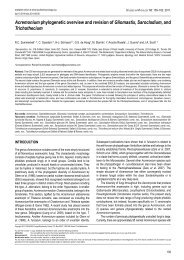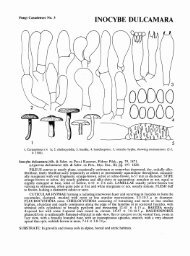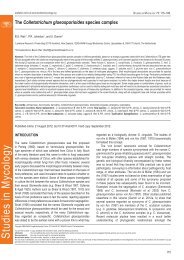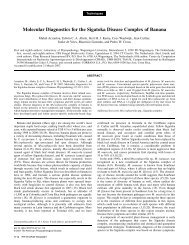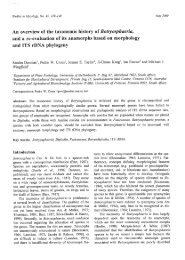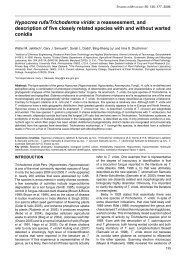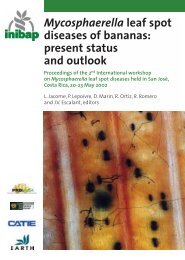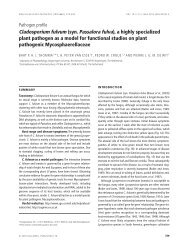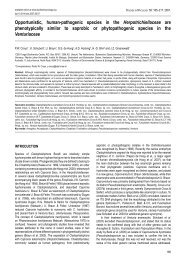Zygomyceten Zygomycota Classification of the Mucorales - CBS
Zygomyceten Zygomycota Classification of the Mucorales - CBS
Zygomyceten Zygomycota Classification of the Mucorales - CBS
Create successful ePaper yourself
Turn your PDF publications into a flip-book with our unique Google optimized e-Paper software.
<strong>Zygomyceten</strong> <strong>Zygomycota</strong><br />
<strong>Classification</strong> <strong>of</strong> <strong>the</strong> <strong>Mucorales</strong><br />
l Mucoraceae<br />
(Absidiaceae)<br />
l Gilbertellaceae<br />
l Saksenaeaceae<br />
l Phycomycetaceae<br />
l Pilobolaceae<br />
l Mortierellaceae<br />
l Choanephoraceae<br />
l Thamnidiaceae<br />
l Cunninghamellaceae<br />
l Mycotyphaceae<br />
l Syncephalastraceae<br />
l Chaetocladiaceae<br />
l Radiomycetaceae<br />
Zygomycetes<br />
Zygomycetes<br />
l mostly fast-growing fungi<br />
l common as saprophytes in wet<br />
environments like food, plants, dung g<br />
l spoilage organisms in fruit, food and<br />
beverages<br />
l important as fermentation agent for food<br />
l used extensively in <strong>the</strong> biotechnology for<br />
enzymes
<strong>Zygomycota</strong> : Zygomycetes<br />
l Most species grow at normal room<br />
temperature<br />
l some are psychrophilic<br />
l species <strong>of</strong> Absidia, Rhizopus, Rhizomucor are<br />
<strong>of</strong>ten <strong>the</strong>rmotolerant or <strong>the</strong>rmophilic<br />
l <strong>the</strong>rmotolerant and <strong>the</strong>rmophilic species are<br />
known as pathogenic or can be potentially<br />
pathogenic<br />
<strong>Zygomycota</strong>: Zygomycetes<br />
o typical coenocytic mycelium<br />
o sexual form = zygospores<br />
o asexual form sporangiospores<br />
Germ sporangium<br />
zygospore<br />
sporangiospores<br />
gametangia<br />
+ -<br />
mycelium<br />
Life cycle <strong>of</strong> <strong>the</strong> <strong>Mucorales</strong> (Phycomyces sp.)<br />
Sporangiophores<br />
with sporangia<br />
Sporangiophore and sporangium<br />
coenocytic mycelium<br />
= hyphae without crosswalls (septa) at<br />
regular distances<br />
Sporangiophores and<br />
sporangia in Mucor
Coenocytic mycelium <strong>of</strong> a Zygomycete<br />
Zygospores<br />
l mostly thick-walled spores with ornamented<br />
walls and sometimes with hyphal covering<br />
l <strong>the</strong> function is like a resting spore<br />
l zygospores are (mostly) absent in cultures<br />
and only found in homothallic isolates<br />
l for heterothallic species crossing (matings)<br />
should be performed<br />
Zygospores<br />
Sexual reproduction by<br />
zygospores<br />
zygospore<br />
Suspensor<br />
cell<br />
Crossing between two matings partners <strong>of</strong> Mucor hiemalis
Zygospores<br />
<strong>of</strong><br />
a heterothallic<br />
species<br />
Asexual development in<br />
Zygomycetes<br />
• Multi-spored sporangium<br />
• Few-spored and mono-spored<br />
sporangium (sporangiole)<br />
• Merosporangium<br />
Zygospores <strong>of</strong> a homothallic species Mucor<br />
genevensis<br />
sporangia<br />
• Characteristics for identification
Asexual reproduction in sporangia<br />
Asexual reproduction in sporangia<br />
sporangiospores<br />
columella<br />
Mucor<br />
Rhizomucor<br />
Absidia<br />
Rhizopus<br />
apophysis<br />
Sporangium with spores<br />
Mucor<br />
Sporangioles: one or few spored sporangia<br />
Asexual reproduction in<br />
sporangia<br />
columella<br />
Mucor<br />
Sporangium with apophysis<br />
Rhizopus
Mucor<br />
• ca. 50 species, cosmopolitan<br />
• Sporangiophores branched or<br />
unbranched (racemose, (racemose sympodial)<br />
• Sporangium with columella<br />
• No apophysis<br />
chlamydospore<br />
c<br />
o<br />
r<br />
Mucor<br />
sporangium<br />
columella<br />
Main axis<br />
racemose<br />
sporangium<br />
• ca. 20 species,<br />
widespread, mostly soilborne<br />
• Sporangiophores<br />
branched<br />
• Sporangium with<br />
columella and apophysis<br />
• Occurrence: soil, grains,<br />
hay, fruits, indoor etc.<br />
• Some species can be<br />
pathogenic for humans<br />
and animals<br />
branching<br />
1 2 3<br />
Absidia<br />
sympodial
Rhizopus<br />
• Ca. 10 species, widespread<br />
• Sporangiophores unbranched<br />
unbranched,<br />
pigmented, solitary or in groups<br />
• Rhizoids opposite sporangiophores<br />
• Stolons (e.g. Rhizopus stolonifer)<br />
• Sporangia with apophysis and columella<br />
stolon<br />
Rhizopus stolonifer<br />
rhizoids<br />
stolon<br />
sporangium<br />
apophysis<br />
rhizoid<br />
columella<br />
apophysis<br />
Rhizopus
Syncephalastrum<br />
• 2 species, widespread with a preference<br />
for tropical and subtropical regions<br />
• Merosporangium and merospores<br />
• Occurring in soil, hay,dung, food and<br />
feed<br />
The End<br />
Asexual reproduction in sporangia:<br />
Merosporangium<br />
vesicle<br />
Merosporangia with<br />
spores in rows<br />
Syncephalastrum<br />
Life cycle <strong>of</strong> <strong>the</strong> <strong>Mucorales</strong> (Rhizopus stolonifer)




